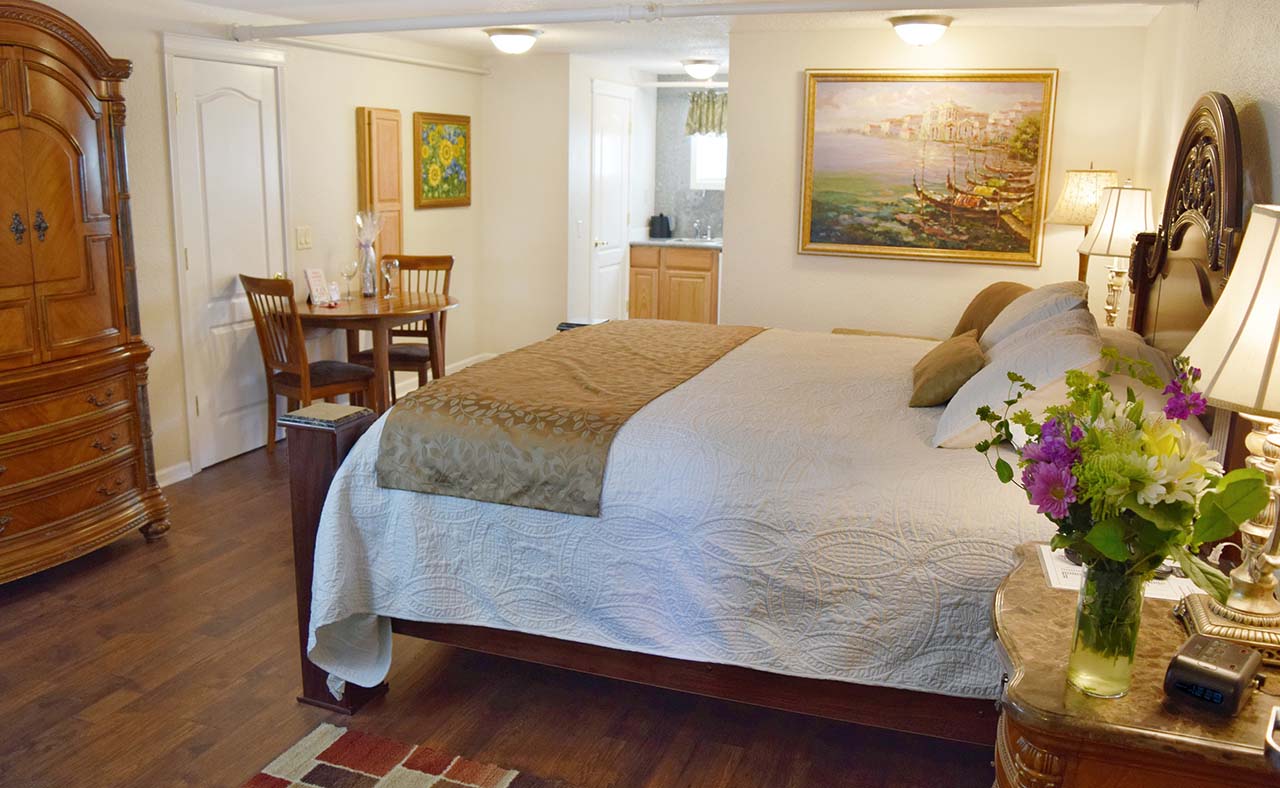
The Abbey Room
Search Rooms
Mt. Angel was originally settled in 1850 by Benjamin Cleaver, who later planned a town site which he named Roy. In 1881, a railroad station was established and named Fillmore after a railroad official. The following year, a post office with the name of Roy was established, but neither name was to last.
Rev. Fr. Adelheim Odermatt came to Oregon in 1881 with a contingent of Benedictine monks from Engelberg, Switzerland, in order to establish a new American daughter house. After visiting several locations, he found Lone Butte to be the ideal location for a new abbey, and shortly afterwards ministered to several local Roman Catholic parishes, about the same time large numbers of immigrants from Bavaria settled in the area. Due to his efforts, the city, post office and the nearby elevation Lone Butte came to be known as Mount Angel (an English translation of Engelberg) in 1883. He also established Mount Angel Abbey, a Benedictine monastery and school, which was moved permanently to Mt. Angel in 1884.
Room Amenities
- One King Bed
- Kitchenette
- Bathroom With Shower / Tub
- Smart Tv
- Wi-Fi Internet
- Heat / Air Conditioner
- Alarm Clock / Radio
- Coffee Maker
- Hair Dryer
- Iron & Ironing Board
The city of Mt. Angel was incorporated April 3, 1893. The post office of Saint Benedict, Oregon was established at the Abbey.
Mount Angel Abbey is located on Lone Butte. The original Kalapuyan (Native American) name of the butte is Tapalamaho, which translates to “Mount of Communion.” At the request of the Archbishop of Oregon City, the abbey opened Mount Angel Seminary in 1889 for the training of priests. The original wooden buildings at the foot of the butte were destroyed in a fire in the 1890s, and another disastrous fire in 1926 consumed the second monastery, an imposing five-story edifice of black basalt at the top of the butte. The current monastery building was completed in 1928, and subsequent structures followed, including a library built by Finnish architect Alvar Aalto in 1970. A bell tower was added to the abbey church in 2007 which contains eight bells, one of which is the largest swinging bell in the Pacific Northwest.
The Monastery Bells: The Abbey’s peal of eight cast bronze bells is housed in the Tower of the Visitation. The six largest bells swing at their own pendular rate assisted by electric motors. The two smaller bells are stationary, sounding by means of a “doplar” interior strike clapper. All eight bells have bronze outside strike hammers, as well.
The Martin Ott Pipe Organs: The pipe organs at Mount Angel Abbey, were built by the Martin Ott Pipe Organ Company of St. Louis, Missouri. The Choir organ and Grand organ are mechanical-action instruments designed and constructed according to classic German organ building principles. The bells were cast by the Petit & Fritsen Bell Foundry, the Royal Dutch Founder, Aarle-Rixtel, Holland, and installed by the Verdin Company of Cincinnati, Ohio in 2007.
The Library: The Swiss monks brought a sizable library with them to Oregon. Unfortunately, only a few books survived a disastrous fire in 1926, which destroyed the library as well as the rest of the abbey. The few volumes which survived reminded later generations of monks of their roots and of the generosity of the founding monastery.
The nucleus of the current library collection was secured in 1932, when the contents of a used bookstore were purchased in Aachen, Germany. For the next twenty years, as the monks worked to rebuild the abbey and the seminary, the library’s collection grew slowly. In 1952 Fr. Barnabas Reasoner, O.S.B., returned from library school to become the director. He introduced modern library procedures and began to build the collection. Fr. Barnabas adopted the Library of Congress classification system and planned the new Aalto-designed library, which was dedicated in 1970. In the late 1980s and early 1990s, library director Fr. Hugh Feiss greatly expanded the library’s holdings in philosophy, Patristics, and Latin Christian studies.
Because of his love of libraries and the special qualities of the Mount Angel Abbey site, Aalto agreed to design the library for a nominal fee. The building was completely funded through the generosity of Howard and Jean Vollum, who also contributed to the library’s endowment.
The architecture of the Abbey Library reflects and shapes its spirit and purpose. The building’s natural light illumines the multi-color bindings of the books which are offered on open stacks against a disciplined black and white background, softened by undulating curves and light colored wood. The structure, including three stories and a mezzanine, was completed in 1970. The entire library, with the exception of the bottom floor, is awash in natural light.
The Seminary: The monks opened their school in 1887, under the name of Mount Angel College. In 1889, Archbishop William Gross of Oregon City asked the monks to establish a seminary in conjunction with their college. Since that time, the Seminary has operated continuously. Over the years, as the Church’s needs, expectations, and ideas about ministry have changed, so has the Seminary. Although the primary focus is still the education of priestly ministers for dioceses and religious communities, the school is open to non-seminarians who are looking for an excellent education in preparation for some aspect of ministry within the Church.
In the 1970s, burdened with growing operating costs and complexity, Mount Angel College and its associated high school closed. Counting 25 lay students working toward advanced degrees in theology, enrollment in the Seminary totals just under 200.
The Retreat House: Situated on the south-east side of the Abbey hilltop, the Retreat House offers a spectacular panoramic view of the Willamette Valley to the south and a serene, peaceful view of the campus mall with our Romanesque Abbey Church, bell tower and Monastery to the north.
In the Retreat House you’ll find quiet and comfortable areas conducive to reading, rest and reflection, along with a beautiful little prayer chapel and reading room on the main floor. There are conference facilities, counseling rooms, a spacious dining room and a beautiful Mediterranean outdoor garden.
Museum: Mount Angel Abbey’s Museum has a rather eccentric collection of artifacts. Here you will find everything from the North American mammal collection, to what is believed to be the world’s largest porcine (from a hog) hairball. Also found in our museum are the expected items such as antique liturgical vestments, American civil war memorabilia and natural history artifacts, just to name a few.
Mt. Angel Abbey is an astounding, historic, reverent, reflective, and remarkably beautiful place that must be visited in person to truly appreciate. The website is www.mountangelabbey.org, where you can find driving directions and hours. Or call 503-845-3030

